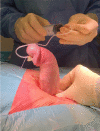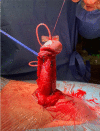Surgical outcomes after collagenase Clostridium histolyticum failure in patients with Peyronie's disease in a multicenter clinical study
- PMID: 33420247
- PMCID: PMC7794401
- DOI: 10.1038/s41598-020-80551-3
Surgical outcomes after collagenase Clostridium histolyticum failure in patients with Peyronie's disease in a multicenter clinical study
Abstract
In the present study we aimed to investigate the surgical outcomes of patients with persistent penile curvature (PC) after Collagenase Clostridium histolyticum (CCH) intraplaque injections. Data from 90 patients with persistent PC after CCH in a multicentre study from 6 andrological centres were retrospectively reviewed. Three standardized surgical techniques were performed. Group 1: plaque incision grafting (PIG) with penile prosthesis implant (PPI); Group 2: PIG without PPI; Group 3: Nesbit technique. Hospital stay, operative time, postoperative complications and PC persistency/recurrence (> 20°) were evaluated. Overall satisfaction and functional outcomes were assessed through International Index of Erectile Function-Erectile Function (IIEF-EF), Peyronie's Disease Questionnaire (PDQ), Female Sexual Function Index (FSFI) administered pre and 3 months postoperatively. Of all, 25 (27.8%) patients received grafting procedure + PPI (Group 1), 18 (20.0%) patients belonged to Group 2, and 47 (52.2%) to Group 3. Bovine pericardium graft and collagen fleece have been used in in 22 (51.2%) and 21 (48.8%) patients, respectively. Median penile length after surgery was 13.0 cm (IQR 12.0-15.0). After surgery, Group 1 showed higher increase in penile length after surgery and better improvements in terms of PDQ-PS. In contrast, both IIEF-EF and FSFI scores did not differ among groups. Overall, 86 (95.6%) did not report any complication. 4 (4.4%) patients had PC recurrence; of those, 2 (8.0%), 1 (5.6%) and 1 (2.1%) cases were observed in Group 1, Group 2 and Group 3, respectively. In case of persistent PC after CCH, surgical correction by grafting with or without concomitant PPI or Nesbit technique emerged as a technically feasible, effective and safe procedure, with no significant postoperative complications.
Conflict of interest statement
The authors declare no competing interests.
Figures



Comment in
-
Male and Female Sexual Function and Dysfunction; Andrology.J Urol. 2021 Jul;206(1):141-144. doi: 10.1097/JU.0000000000001808. Epub 2021 Apr 21. J Urol. 2021. PMID: 33881348 No abstract available.
Similar articles
-
Surgical correction of persistent Peyronie's disease following collagenase clostridium histolyticum treatment.J Sex Med. 2015 Jan;12(1):259-64. doi: 10.1111/jsm.12721. Epub 2014 Oct 27. J Sex Med. 2015. PMID: 25345351
-
Characteristics of Men With Peyronie's Disease and Collagenase Clostridium Histolyticum Treatment Failure: Predictors of Surgical Intervention and Outcomes.J Sex Med. 2020 May;17(5):1005-1011. doi: 10.1016/j.jsxm.2020.02.002. Epub 2020 Feb 29. J Sex Med. 2020. PMID: 32127330
-
Predictive Factors of Patients' and Their Partners' Sexual Function Improvement After Collagenase Clostridium Histolyticum Injection for Peyronie's Disease: Results From a Multi-Center Single-Arm Study.J Sex Med. 2018 May;15(5):716-721. doi: 10.1016/j.jsxm.2018.03.084. J Sex Med. 2018. PMID: 29699756
-
Outcomes of Surgery in Peyronie's Disease Following Intralesional Collagenase Clostridium Histolyticum Injections.Curr Urol Rep. 2019 Jun 14;20(8):42. doi: 10.1007/s11934-019-0910-8. Curr Urol Rep. 2019. PMID: 31201571 Review.
-
Management of Peyronie's disease with collagenase Clostridium histolyticum in the acute phase.World J Urol. 2020 Feb;38(2):299-304. doi: 10.1007/s00345-019-02791-x. Epub 2019 May 15. World J Urol. 2020. PMID: 31093703 Review.
Cited by
-
Use of grafting materials during penile prosthesis implantation in patients with Peyronie's disease-a systematic review.Int J Impot Res. 2022 Sep;34(6):534-542. doi: 10.1038/s41443-021-00479-8. Epub 2021 Oct 30. Int J Impot Res. 2022. PMID: 34718344
-
"Can we try to avoid surgery first?"-Real-world experience with surgery for Peyronie's disease in the post-intralesional collagenase setting.Int J Impot Res. 2024 Apr;36(2):171-172. doi: 10.1038/s41443-023-00713-5. Epub 2023 May 4. Int J Impot Res. 2024. PMID: 37142832 No abstract available.
-
Penile reconstruction: An up-to-date review of the literature.Arab J Urol. 2021 Jul 26;19(3):353-362. doi: 10.1080/2090598X.2021.1957410. eCollection 2021. Arab J Urol. 2021. PMID: 34552786 Free PMC article. Review.
-
Pathological Significance of Macrophages in Erectile Dysfunction Including Peyronie's Disease.Biomedicines. 2021 Nov 10;9(11):1658. doi: 10.3390/biomedicines9111658. Biomedicines. 2021. PMID: 34829887 Free PMC article. Review.
References
Publication types
MeSH terms
Substances
LinkOut - more resources
Full Text Sources
Other Literature Sources

